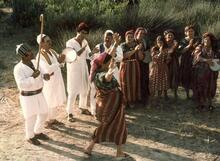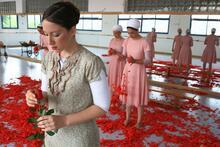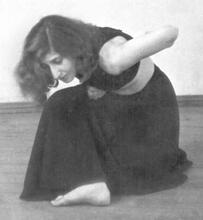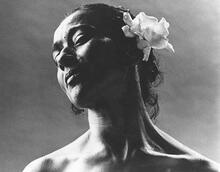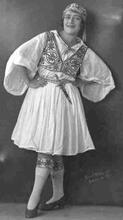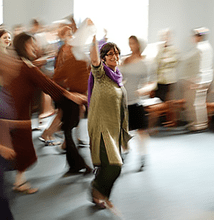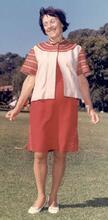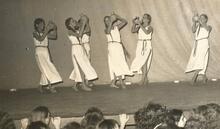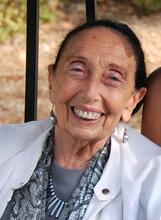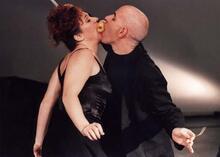Folk Dance, Israeli
Folk dances in Israel are a staple of the national and cultural consciousness and were largely created and performed by women. During the Second and Third Aliyah periods, between 1904 and 1923, the halutzim danced only dances that they had brought with them from the Diaspora—the Horah, Polka, Krakowiak, Czerkassiya, and Rondo, with the Horah becoming the national dance. The choreography of original dances flourished between 1923 and 1943, when dance teachers began to choreograph dances for festival pageants. The halutzim's festival pageants led to the creation of many beautiful holiday dances. Israeli society saw the importance of folk dance as a source of enjoyment that had positive zionist values. Today there are some three thousand Israeli folk dances, according to folk-dance instructors.
Introduction
For the halutzim (pioneers), Israeli folk dances were originally an expression of ideology and values in the guise of pleasurable and liberating leisure activity. As a result, it is possible to identify a veritable “movement” of Israeli dance, in which women played a primary role, although Barukh Aggadati (1895–1976), a unique pioneer on the pre-state artistic scene, created and performed the first Israeli folk dance in Tel Aviv in 1924. Entitled “Urah Galilit,” it was initially a solo dance with a shepherd’s staff, which was later transformed into a group dance for a performance by the Ohel Theater company. Gurit Kadman revised it, changing its name to “Horah Aggadati,” which it is still known and danced to this day.
In Aggadati’s time, dance was an artistic activity in which women were the outstanding participants. They were also the first to feel a need to find a new expression of the Jewish festivals for their children, laying the foundations for Israeli folk dance, beginning in the 1930s and burgeoning in the 1940s.
Among the outstanding choreographers who created festival and folk dances were Leah Bergstein (Beit Alpha and Ramat Yohanan), Rivka Sturman (Ein Harod), Gurit Kadman (Tel Aviv), Zashka Rosenthal (Gan Shmuel), Yardena Cohen (Haifa), Rachel Nadav (Tel Aviv), Sarah Levi-Tanai (who started as a kindergarten teacher in Ramat ha-Kovesh), and Tova Zimbel (Hadassim).
The leaders of the next generation of choreographers and instructors were men, who also constitute the majority of present-day choreographers and instructors, though most of the dancers are women. Society came to attribute the importance of folk dance as a source of enjoyment that had positive values, from the social mobility and world-wide travel associated with folk-dance instruction, to the commercial possibilities inherent in choreographing and teaching folk dances and preparing Israeli groups for public performances.
In the subject, content, and form of the dances created sixty years ago and even today, especially those folk dances performed on stage, men and women fill traditional stereotypical roles: the man reaps while the woman gathers sheaves; the man courts and the woman flirts; the man is the shepherd and the women are the sheep; the man leads and the woman is led. This may be because folklore tends to preserve heteronormative traditions.
The History of Israeli Folk Dance
The need for community dances first arose among the halutzim of the First Lit. "ascent." A "calling up" to the Torah during its reading in the synagogue.Aliyah in 1882, continuing with the Second Aliyah (1904–1914) and the Third Aliyah (1919–1923). During the Second and Third Aliyah periods, between 1904 and 1923, the halutzim danced only dances that they had brought with them from the Diaspora—the Horah, Polka, Krakowiak, Czerkassiya, and Rondo, with the Horah becoming the national dance.
The choreography of original dances by professional dancers began in the twenty-year period between 1923 and 1943 when dance teachers began to choreograph dances for festival pageants. Several of these dances also became folk dances.
The Israeli folk dance “movement” was born between the years 1944 and 1948. In folk-dance circles, the history of this movement is chronicled according to the dates of the national dance festivals, the first of which was held at A voluntary collective community, mainly agricultural, in which there is no private wealth and which is responsible for all the needs of its members and their families.Kibbutz Daliyyah in the hills of the Ephraim region in July, 1944. Gurit Kadman, who planned and organized all the Daliyyah festivals, prepared a booklet (published by the Kibbutz Seminar) which contained twenty-two The Land of Israel Erez Israel folk dances, eight of them original and the rest based on international folk dances (e.g. Horah Aggadati, Alexandrova, Czerkassiya, Double Czerkassiya, Scotch, Lithuanian Polka, Tel-Aviviyyah, and Triple Debka).
Fourteen folk-dance groups appeared at the first Daliyyah festival, performing international folk dances as well as original Israeli and Biblical ones. A group from En-Harod, led by Rivka Sturman, performed a dance called “Ha-Goren” (The Barn). The new dance “Mayim, Mayim” (Water, Water), which Elsa Dublon had choreographed to music by Yehuda Sharett for the water pageant for the 1937 Water Festival in Na’an, gained national exposure.
The second national folk-dance festival, which took place at Kibbutz Daliyyah in July 1947, has remained in the collective memory because of the nighttime curfew that the British authorities imposed on the roads. Five hundred dancers and twenty-five thousand spectators remained in the Kibbutz Daliyyah amphitheater overnight, singing and dancing, transforming national folk dance into one more symbol of the struggle for independence against the Mandate for Palestine given to Great Britain by the League of Nations in April 1920 to administer Palestine and establish a national home for the Jewish people. It was terminated with the establishment of the State of Israel on May 14, 1948.British Mandate.
Two further folk-dance festivals took place at Kibbutz Daliyyah, in 1951 and 1958. During this period Rivka Sturman, Leah Bergstein, Gurit Kadman, Sara Levi Tannai, Ze’ev Havazzelet, Shalom Hermon, Tamar Eligur, Yoav Ashriel, Yonatan Karmon, and others choreographed festival and folk dances. Large dance events were held all over the country and the first annual dance parade was held in Haifa in 1953.
At the fifth Daliyyah festival in 1968, leaders of the folk-dance movement expressed regret at the tendency toward ostentation and showy staging which characterized the folk dances performed. Since then, folk-dance festivals have taken place throughout the country, a major one being that in Karmiel, planned by Yonatan Karmon, which has been held annually since 1988.
Dances for Festival Pageants
The first folk dances in The Land of IsraelErez Israel were created for Jewish holiday and festival pageants on A voluntary collective community, mainly agricultural, in which there is no private wealth and which is responsible for all the needs of its members and their families.kibbutzim, for which the early choreographers sought to create patterns that would revive ancient ceremonies and create new ones for agricultural and historical festivals. Their creators saw them as artistic dances suitable for amateur performance. Sometimes such a dance became popular, crossing the boundaries from pageantry to folk dance.
In a fascinating attempt on the part of the halutzim to create holiday ceremonies that were influenced by the Zionist ideology of an ancient people reborn in its ancient homeland, festival pageants led to the creation of many beautiful holiday songs and dances. The ceremonies expressed the daily life and dreams of halutz society, echoing ancient Biblical tradition while excluding many of the elements of traditional religious ritual. The sources of inspiration of the Israeli folk dances were the stories and words of the Bible; although the pioneers did not know how our ancestors danced in Biblical times, they used their imagination. Other sources were Slavic and Balkan dances, Hasidic dances, dances of Yemenite Jews, and the traditional dances of the Arabs. Despite the heterogeneity of their sources, Israeli dances developed a style of their own.
The Viennese researcher, artist and teacher of dance, Rudolph von Laban (1879–1958), was another source of inspiration for festival pageants in pre-state Israel during the 1920s and 1930s. Fearing that the creation of popular dance was about to die out, he sought to serve society by devising new popular dances. At the end of the 1920s and the beginning of the 1930s, von Laban organized the giant annual parade of trade unions in Vienna, creating movement choruses and speaking choruses whose function was to express socialist ideas. The accompanying choreography, though interesting and complex, was essentially based on simple movements that anyone could perform. He thus designed a broad base of creative artistic activity of large dimensions without the need for professional dancers, while using a large number of participants to create complex and impressive scenes at mass popular events. This was proletarian art, which allowed both the artist and the masses to express themselves.
Pre-state Israel was the ideal place for von Laban’s dreams to be translated into action (this was before his affiliation with the Nazi state). His ideas gave rise to the festival pageants—a combination of declaimed and sung text and festival dances, of which the first were choreographed in the 1930s by women dance teachers: Leah Bergstein, Rivka Sturman, Gurit Kadman, Zashka Rosenthal, Yardena Cohen, and Sara Levi-Tanai. Some of the dances choreographed for festival pageants on kibbutzim became the first Israeli folk dances and provided the prototypes for future dances. Israeli folk dances are a unique phenomenon of contemporary folklore; in spite of the many changes in the values, dreams, and ways of life of the Israelis, they still dance the old dances of the 1940s and 1950s—the years during which more new dances were created than in any other culture in the world. Today there are some three thousand Israeli folk dances, according to folk-dance instructors. However, some of these dances are no longer danced.
There are also other counts of the dances; for example, on the Israeli website www.rokdim.co.il, managed by Yaron Meishar, only 2,200 dances are listed. This list documents only dances which are currently being danced and for which instructional video tapes exist.
The international site www.israelidances.com documents four thousand Israeli folk dances, which include both dances created in Israel and abroad, for both the Israeli the overseas public..
About one hundred thousand people dance on a regular basis at least once a week and an additional one hundred thousand dance several times a year (according to a Tel-Seker survey in 1994 for the Rokdim magazine).
Hebrew
Almog, Oz. The Image of the Sabra. Tel Aviv: 1997.
Ashkenazy, Ruth. The Story of Folk Dance on Kibbutz Daliyyah. Haifa: 1992.
Bahat-Ratzon, Naomi, ed. Barefoot: The Yemenite Jewish Tradition in Israeli Folk Dance. Tel Aviv: 1999.
Cohen, Yardena. Drum and Dance. Tel Aviv: 1976.
Eshel, Ruth. Dancing with the Dream: The Beginning of Artistic Dance in Israel 1920–1964. Tel Aviv: 1991.
Goren, Yoram. Fields Dressed in Dance: On Leah Bergstein and Her Contribution to Israeli Dance and Festivals. Ramat Yohanan: 1988.
Friedhaber, Zvi. Dance in Israel. Wingate Institute. Netanyah, Israel: 1984.
Idem. Gurit Kadman, Mother and Bride. Jewish Dance Archive: 1990.
Idem. Folk Dances of Israel. Jewish Dance Archive: 1969.
Ha-Reuveni, Nogah. Desert and Shepherd in Israeli Tradition. Neot Kedummim: 1991.
Kadman, Gurit. A Nation Dances. Jerusalem and Tel Aviv: 1969.
Manor, Giora. Gertrud Kraus’s Life in Dance. Tel Aviv: 1978.
Idem. Aggadati: A New Dance Pioneer in Erez Israel. Tel Aviv: 1978.
Raskin, Hillel, ed. Circles of Peace: Shalom Hermon—Leader, Educator and Choreographer. Hermon Family, Jerusalem: 1997.
Roginsky, Dina. “Sixty Years to the First Dalia Conference 1944–2004, Changes in Israeli Folkdances.” Dance Today the Dance Magazine of Israel, Ruth Eshel (ed.) No. 11 (November 2004): Tel Aviv.
Ronen, Dan. “Jubilee Celebrations for Israeli Folk Dance.” Dance in Israel 4 (October 1994).
Idem. “A Dialog of Connection: The Search for Locality and Native Israeliness in the Creation of Folk Dances in the 1950s.” In The Challenge of Sovereignty, edited by Mordechai Bar-Or. Jerusalem: 1999.
Idem. “Folklore for the Stage and a Stage for Folklore.” Dance Now 2 (July 2000).
Idem. “Israeliness in the Eyes of Longing: Karmon in Dance.” Dance Now 5 (June 2001).
Idem. “Dance for Everyone: On Multiculturalism in Israel and Its Influence on Dance.” Dance Now 3 (November 2000).
Idem. “What Happens to Dances: Process and Predictions.” Dance in Israel 7 (December 1995).
Idem. “The Man Reaps and the Woman Gathers Sheaves: Gender Equality in Israeli Folk Dance.” Dance Now 4 (March 2001).
Shavit, Ya’akov. “The Missing Cultural Dimension and Its Fulfillment: Between ‘Official Folk Culture’ and ‘Unofficial Folk Culture’ in Hebrew National Culture in Israel.” In Folk Culture, edited by B. Z. Kedar. Jerusalem: 1979.
Zeira, Motti. We Are Torn. Jerusalem: 2002.


